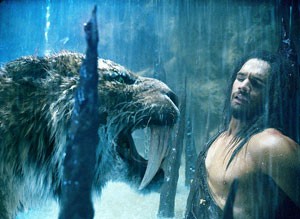“”10,000 B.C.”” is remarkably similar to Mel Gibson’s “”Apocalypto,”” except that it’s bad. The premise of the film mirrors “”Apocalypto”” very closely. In the beginning, the audience is introduced to characters from an ancient culture far different from their own. Complete with piercings and face paint, tribal inhabitants chant and convulse as they participate in an outlandish and bizarre ritual.
As it turns out, the cause of the ritual is a young, blue-eyed girl who has been rescued from a nearby village. According to Old Mother, the community’s witch doctor, the girl’s village was destroyed by “”four-legged demons,”” a.k.a. men on horses, and their village will soon follow.
“”10,000 B.C.””
Rated PG-13 – 109 mins.
Warner Bros.
2 1/2 stars
Now jump forward 10 years or so. Blue-eyed girl, Evolet (Camilla Belle), and one of the tribe’s hunters, D’Leh (Steven Strait), are in love and destined to live happily ever after. That is until the four-legged demons arrive. The war hungry riders proceed to destroy the town and take most of its occupants with them, including Evolet. The head hunter, Tic’Tic, some other random men and D’Leh, are of course left behind, this way they can follow the captors and make things a bit more dramatic.
Nearly the rest of the film involves Tic’Tic and D’Leh following the captors and gaining support from various other tribes who have been subjected to similar treatment by the “”four-legged demons.””
Creating a movie about an ancient civilization can prove to be difficult. Illustrating unusual traditions, costumes and beliefs can border on hokey, causing the audience to see these things as more of a joke than anything else. This is especially true because the culture is complete fantasy. In all the ways that “”Apocalypto”” managed to avoid this stereotype, “”10,000 B.C.”” plummeted.
While “”Apocalypto”” had factual evidence and history to rely on, “”10,000 B.C.”” is mere imagination. In contrast to “”Apocalypto’s”” huge budget, the film appears to have had far less.
As a result, “”10,000 B.C.”” is ridiculous in many ways. For one, the costumes and villains hold a striking resemblance to those of “”Xena: Warrior Princess.”” All of the villains are huge with deep voices and scars, while many of the costumes look like the work of a desperate mother’s last-minute Halloween costume. The strange accessories and costumes of other tribes look even more like novelty costumes.
Another blinding idiosyncracy in the film is the fact that nearly all of the dialogue is in English. Unlike Gibson, director Roland Emmerich (“”The Day After Tomorrow,”” “”Independence Day””) seems to think audiences would not be literate enough to read subtitles and instead gifted most of his prehistoric characters with the ability to speak English, with a slight, obscure accent of course.
This was a debilitating mistake on his part. In a film that absolutely required the audience to believe that they were in an ancient and strange time, Emmerich had his characters speaking crystal-clear English.
Other deep flaws in the film were both the script and the acting. It seemed as though Emmerich tried to compensate for his use of English by adopting a dialogue that was very short and simple. This translated, however, into awkward and unbelievable acting. A particularly goofy line in the film occurs when D’Leh frees a “”spear tooth”” tiger from a trap. The sentence is something along the lines of, “”If I set you free, you better not eat me.”” While this appears to have been a serious point in the film, it was met with chuckles throughout the audience.
One way in which the film greatly succeeds is in the computer generated images. Much like “”The Day After Tomorrow”” and “”Independence Day,”” the CGI is beautiful. Massive mammoths are strikingly realistic and interact seamlessly with both the environment and human characters. While this is entertaining to look at, it doesn’t save the film.
Luckily, I would guess that “”10,000 B.C.”” will be hitting the cheaper seats relatively soon, making the unrealistic endeavor much more affordable. A $3 price tag might be worth the eye-candy, but avoid paying any more than that to see it.









